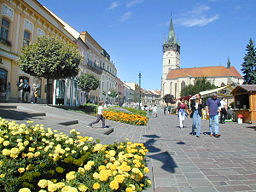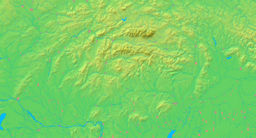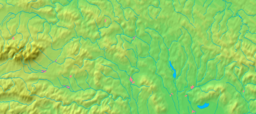Prešov
| Prešov | |
| City | |
 City centre of Prešov
|
|
| Country | |
|---|---|
| Region | Prešov |
| District | Prešov |
| Tourism region | Šariš |
| River | Torysa |
| Elevation | 250 m (820 ft) |
| Coordinates | |
| Area | 70.40 km² (27.2 sq mi) |
| Population | 91,650 (2006-12-31) |
| Density | 1,302 /km² (3,372 /sq mi) |
| First mentioned | 1247 |
| Mayor | Pavel Hagyari (independent) |
| Timezone | CET (UTC+1) |
| - summer (DST) | CEST (UTC+2) |
| Postal code | 080 01 |
| Area code | +421-51 |
| Car plate | PO |
  Location in Slovakia
|
|
  Location in the Prešov Region
|
|
| Wikimedia Commons: Prešov | |
| Statistics: MOŠ/MIS | |
| Website: www.presov.sk | |

Prešov (pronunciation; known also by alternative names) is a city in eastern Slovakia. It is the seat of the administrative Prešov Region (Slovak: Prešovský kraj). With a population of approximately 91,000, it is the third-largest city in the country.
Contents |
Etymology
The city name originates in the Hungarian word "eper" which means strawberry.[1] The city's historical coat of arms also contains strawberries.[1]
Historically, the city has been known as Eperjes in Hungarian, Eperies or Preschau in German, Fragopolis in Latin, Preszów in Polish, Peryeshis in Romany, Пряшів/Пряшyв (Priashiv/Priashuv) i and Пряшів in Ukrainian.
Characteristics
The city is a showcase of Baroque, Rococo and Gothic architecture. In the historical center, the main street is lined with churches and other buildings built in these styles. In the suburbs, however, the Soviet influence is clearly evident through the massive concrete apartment buildings (the paneláky) of the Sídliská (housing estates) and the Sekčov district. More Soviet-style architecture is seen in the government buildings near the city center.
Significant industries in the city include mechanical and electrical engineering companies and the clothing industry. Solivary, the only salt mining and processing company in Slovakia, also operates in the city. The city is a seat of an Orthodox archbishopric.
Many concerts, operas, operettas and stage plays are performed at the new building of the Jonáš Záborský Theatre (Divadlo Jonáša Záborského), as well as at the older theatre premises.
The city and the region are contenders for European Capital of Culture 2013.[2]
History
Habitation in the region of Prešov dates as far back as the Paleolithic period. The oldest discovered tools and mammoth bones are 28,000 years old. The continuous settlement dates to the 8th century.
By the end of the 11th century the town had become part of the Kingdom of Hungary, and Hungarian soldiers settled in the town. According to the legend today's was founded in 1132 by King of Hungary, Blind Béla[3] and named after strawberries planted nearby.[4] In the 13th century many German settlers moved to Prešov from the Spiš region, after the Mongol invasions of 1241. The first written record of Prešov dates back to 1247 in a document of the King Béla IV, when it was mentioned as Epuries. At that time it was a village belonging to the nearby Šariš Castle.[5] In 1299 Prešov received municipal privileges from Andrew III, and in 1374 it was declared a free royal town. This led to the development of crafts and trade (especially the export of wine from the Tisza region to Poland). In the 15th century Prešov joined the Pentapolitana, an alliance of five towns of eastern Slovakia (Bardejov, Levoča, Košice, Prešov, and Sabinov).
The first record of a school dates to 1429. In 1572, salt mining began in Solivar (at that time a nearby town, now part of Prešov). Prešov's increased importance meant that in 1647 it became the seat of the Šariš county.
In 1667 the important Evangelic Lutheran College of Prešov was established by Lutherans in the town. In 1687 twenty four prominent citizens and noblemen were executed for supporting the uprising of Imre Thököly.
At the beginning of the 18th century, the population was decimated by the Bubonic plague and by fires to a mere 2,000 inhabitants. By the second half of the century the town had recovered, crafts and trade improved again, and new factories were built. In 1752 the salt mine in Solivar was flooded. Ever since then salt has been produced from salt brine through boiling.
In 1870 the first railway was built to the town from Košice. At the end of the 19th century, the town introduced electricity, telephone, telegraph, and a sewage system. In 1887 fire destroyed a large part of the town. In 1918 Prešov became part of the newly created Czechoslovakia. During World War II, the nearby town of Košice became again part of Hungary by the First Vienna Award. As a result, many institutions moved from Košice to Prešov, thus increasing its importance. In 1944, a professional Slovak Theatre was established in Prešov.
During the Communist Czechoslovakia era after 1948, Prešov became an industrial center. The population increased rapidly from 28,000 in 1950 to 52,000 in 1970 and 91,000 in 1990.
Geography

Prešov lies at an altitude of 250 metres (820 ft) above sea level and covers an area of 70.4 square kilometres (27.2 sq mi).[6] It is located in the north-eastern Slovakia, at the northern reaches of the Košice Basin, at the confluence of the Torysa River with its tributary Sekčov. Mountain ranges nearby include Slanské vrchy (south-east), Šarišská vrchovina (south-west), Bachureň (west) and Čergov (north). The neighbouring city of Košice is 34 kilometres (21 mi) to the south, around 50 kilometres (31 mi) from the Polish border and 410 kilometres (255 mi) away from Bratislava (by road).
Climate
Prešov lies in the north temperate zone and has a continental climate with four distinct seasons. It is characterized by a significant variation between hot summers and cold, snowy winters.
| Month | Jan | Feb | Mar | Apr | May | Jun | Jul | Aug | Sep | Oct | Nov | Dec | |
|---|---|---|---|---|---|---|---|---|---|---|---|---|---|
| Average high °C (°F) | 0 (32) |
3 (37) |
9 (48) |
15 (59) |
21 (69) |
24 (74) |
25 (78) |
25 (78) |
20 (69) |
14 (58) |
6 (44) |
1 (34) |
|
| Average low °C (°F) | -5 (23) |
-4 (25) |
0 (32) |
5 (40) |
9 (49) |
12 (54) |
14 (57) |
14 (57) |
10 (49) |
5 (41) |
0 (33) |
-4 (26) |
|
| Precipitation cm (inches) | 1.59 (0.63) |
1.89 (0.74) |
1.90 (0.75) |
3.85 (1.52) |
4.48 (1.76) |
5.99 (2.36) |
6.76 (2.66) |
5.09 (2.00) |
3.57 (1.41) |
3.30 (1.30) |
2.91 (1.15) |
1.97 (0.78) |
|
| Source: MSN Weather[7] 2008-01-22 | |||||||||||||
Demographics


Prešov has a population of 91,621 (as of December 31, 2005). According to the 2001 census, 93.7% of inhabitants were Slovaks, 1.4% Roma, 1.2% Rusyns, 1.1% Ukrainians, 0.8% Czechs, and 0.2% Hungarians. The religious make-up was 66.8% Roman Catholics, 13.6% people with no religious affiliation, 8.9% Greek Catholics, 4.8% Lutherans, and 1.68% Orthodox.[6]
Before World War II Prešov had a large Jewish population, and housed a major Jewish museum. Plaques in the town hall and a memorial in the surviving synagogue record that 6,400 Jews were deported from the town under the Tiso government of the First Slovak Republic to the concentration camps run by the Nazi regime of Germany.
Education
Institutions of tertiary education in the city are the University of Prešov with 12,549 students, including 867 doctoral students.[8] and the private International Business College ISM Slovakia in Prešov, with 455 students.[9] In addition, the Faculty of Manufacturing Technologies of the Technical University of Košice is based in the city.
There are 15 public primary schools, six private primary schools, and two religious primary schools.[10] Overall, they enroll 9,079 pupils.[10] The city's system of secondary education consists of 10 gymnasia with 3,675 students,[11] 4 specialized high schools with 5,251 students,[12] and 11 vocational schools with 5,028 students.[13][14]
Hiking trails
- European walking route E8
- Prešov - Miháľov - Kurimka - Dukla - Iwonicz-Zdrój – Rymanów-Zdrój - Puławy – Tokarnia (778 m) – Kamień (717 m) – Komańcza - Cisna - Ustrzyki Górne - Tarnica - Wołosate.
See also
- List of people from Prešov
- Šariš Brewery
- Executive Court of Prešov
Twin towns
Prešov is twinned with:
|
References
- Official History of Prešov
- Prešov town hall (July 2002), Prešov - city profile. Retrieved in June 2004 from http://www.pis.sk/jpis/obsah/html/presov_profile.htm.
Citations
- ↑ 1.0 1.1 "Presov city, Slovakia" (in English). Retrieved on 13 August, 2008.
- ↑ See Presov 2013 website
- ↑ "Eperjes (Prešov, Eperies Sk)" (in Hungarian, Slovak, German, English). Protestáns Honlap. Retrieved on 13 August, 2008.
- ↑ Tibor Horváth, "Szlovákia", p. 140 (Hungarian)
- ↑ "Prešov - Prior to The Grant of The City privileges". City of Prešov (no date). Retrieved on 2008-03-18.
- ↑ 6.0 6.1 "Municipal Statistics". Statistical Office of the Slovak republic. Retrieved on 2008-01-22.
- ↑ "Monthly Averages for Nitra, Slovakia". MSN. Retrieved on 22 January, 2008.
- ↑ "Technická univerzita Košice" (PDF) (in Slovak). Ústav informácií a prognóz školstva. Retrieved on 2008-03-04.
- ↑ "Vysoká škola medzinárodného podnikania ISM Slovakia" (PDF) (in Slovak). Ústav informácií a prognóz školstva. Retrieved on 2008-03-04.
- ↑ 10.0 10.1 "[http://www.uips.sk/statis/pdf/ZS_P7.PDF Prehľad základných škôl v školskom roku 2006/2007]" (in Slovak). Ústav informácií a prognóz školstva (2006). Retrieved on 2008-03-04.
- ↑ "Prehľad gymnázií v školskom roku 2006/2007" (PDF) (in Slovak). Ústav informácií a prognóz školstva. Retrieved on 2008-03-04.
- ↑ "Prehľad stredných odborných škôl v školskom roku 2006/2007" (PDF) (in Slovak). Ústav informácií a prognóz školstva. Retrieved on 2008-03-04.
- ↑ "Prehľad združených stredných škôl v školskom roku 2006/2007" (PDF) (in Slovak). Ústav informácií a prognóz školstva. Retrieved on 2008-03-04.
- ↑ "Prehľad stredných odborných učilíšť a učilíšť v školskom roku 2006/2007" (PDF) (in Slovak). Ústav informácií a prognóz školstva. Retrieved on 2008-03-04.
General references
- Horváth, Tibor (1999) (in Hungarian). Szlovákia (1st ed. ed.). Budapest: Cartographia. ISBN 9633531802CM.
External links
|
|||||||
|
|||||||